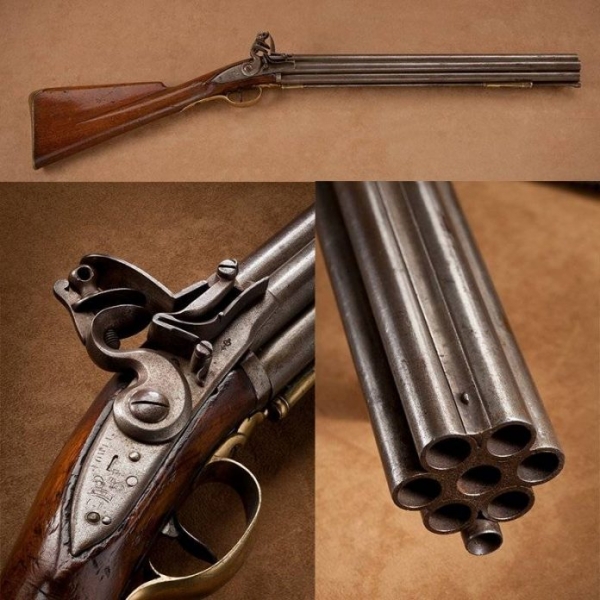
Almost from the beginning of the appearance of firearms designers around the world have tried to achieve increase its rate. The advantages of a massive fire quickly became clear to the military of all countries.
For a long time the only way to increase the rate of fire weapons training was very hand. Well-trained soldiers could do more rounds per minute, in reality, it could have an impact on the outcome of the battle. Another way to increase the rate of change is constructive weapons, and the easiest option was to increase the number of trunks.
It is worth noting, what the idea of increasing the number of trunks was simple, lying on the surface and became one of the first on ways to increase the rate of real firearms. In many countries, the designers have created this multilateral monsters, which can not replace modern machine gun or automatic, but definitely made an impression, even their appearance, as a 14-barreled shotgun, created by the English gunsmith William Dyupe at the beginning of the XIX century.
14-barreled shotgun William Dyupe
English gunsmith William Dyupe created the firearms at the turn of the XIX century, some of its models have survived, the Internet can find a set of dueling pistols of the gunsmith.
However, the greatest interest is the 14-barreled shotgun, which can be seen today in the collection of the Museum of weapons in Liege. It is believed, that the master has made this unusual instance of Colonel Thomas Thornton British Army around the turn of the year 1800.
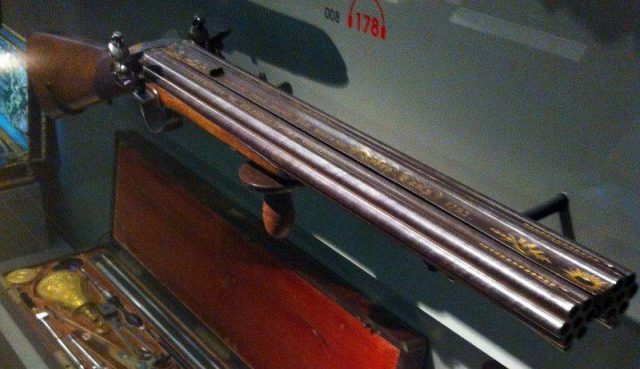
guns feature was the presence of two blocks of seven pieces of trunks. each of 14 trunks had the caliber 12,5 mm. For the weapons of the era of the domination of black powder and round-caliber bullets were too small. Traditional military rifles in those years had the caliber of 15,4 mm, and from the fortress guns he reached 25 mm.
At the same time volley 14-barreled gun could be a powerful argument in any battle or dispute, which had to be solved with weapons. Likely, shooting from unusual gun volleys conducted, which allowed to release the target of seven bullets per shot. The effect of the enemy was a monstrous, As expected returns at the time of shooting.
Weapons could hardly be called a mobile, given the size and weight, which should have been very impressive. It is difficult to understand for what purposes it is such weapons took the British Army Colonel. In combat, the weapon can be used only under specific conditions (defensively in the presence of a suitable strong walls or abutment), hunt with him would be madness, if not to take into account the case, when a deer or other wild animals would not have rushed out to take a position themselves Hunter.
For the original decisions gunsmith include the provision of tactical grip, advanced for its time decision. Without it, keep the gun when a shot, apparently, it was simply impossible.
English boarding assault rifles
Separately, you can select multi-barreled guns, used during boarding fights. We all know the image of a pirate, which is entrenched in the cinema. The on-screen character, preparing to attack the enemy ship, once armed with several pistols. In the world, in which there was no repeating weapons, it was a way out. Another solution was multi-barreled gun model, some of them are more reminiscent of bleed.
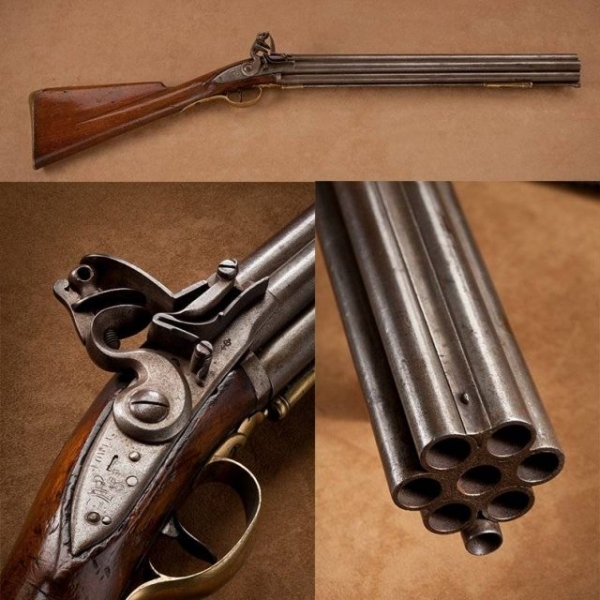 Seven-barreled naval gun Knock
Seven-barreled naval gun Knock
Known models of multilateral small arms include the era of the Napoleonic wars the British naval seven-barreled gun Knock. Weapon fame gained thanks to a series of writer Bernard Cornwell novels, follows the adventures of an arrow Sharpe. The model comes not too big series at the end of XVIII - early XIX centuries. Construction of seven-barreled gun designed by James Wilson, but engaged in the production of the manufacturer Nock, which gave an unusual model firearm its name.
The weapon was a heavy enough (plenty more 6 kg) musket with seven trunks and a flintlock. The gun fired a volley, sending an enemy seven caliber lead bullets 13,2 mm, total weight was volley 170 grams. This salvo literally swept opponents from the deck of an enemy ship.
Despite all its shortcomings, including not firing most outstanding accuracy and great feedback from a shot, weapons found their lovers. In a situation, when the target groups on the ship's deck, it was not so important. The disadvantages of the weapon is also the complexity of care and the length of the charge exchange process, these problems were common to all models of multilateral arms of those years.
Multilateral gun could be used with the boarding enemy ships, and how protivoabordazhnoe weapons. There is also a version of the, unusual gun that could be used by captains of British ships, as a weighty argument, if necessary, to prevent the riot team. In any case, the British government bought the navy about 600 like seven-Nock gun.
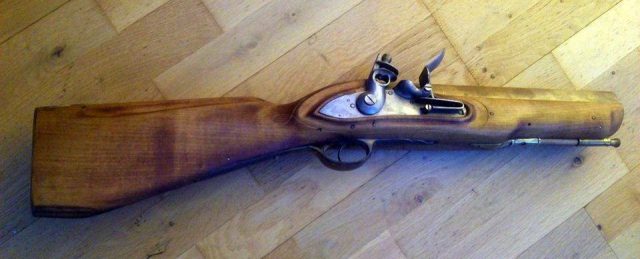
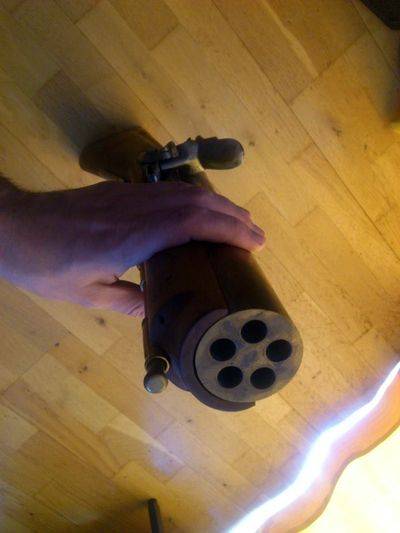 Pyatistvolnoe grappling gun
Pyatistvolnoe grappling gun
Another example of such a boarding weapons presented in strangernn.livejournal.com blog. in the pages of the blog author tells about the assault rifle with five trunks. Basic materials - wood and bronze. Multilateral arms were produced around the same time frame, that unusual 14-barreled shotgun William Dyupe. In this case, it is technologically easier. All five bores were drilled in a large size bronze blank. This is the main difference from the previous model samples, where each barrel was separate.
At sufficiently modest size weight was pyatistvolnogo assault rifles 5,8 kg. At the same weapon it was much shorter than seven-barreled gun Knock, Recalling modern rifles. In battle, it was kind of more convenient.
When boarding battles were quite small and the length of the barrel, anticipated, that the shooter will make a volley almost point-blank before, like jump off the deck and begin to fight with the enemy, using cold weapons. In this regard, ballistics and accuracy had to miss, at least one bullet would certainly have found its target.
Multilateral pepperboksy
Special mention deserve the multi-barreled guns, who also appeared at the turn of XVIII - XIX centuries. They were stuck unusual name "pepperboks". When a literal translation from English means "box and pepper" or simply "pepper".
At first, the term was widely used to all multiply charged pistols, it even used to refer to the first revolvers. But first a word describes a multi-barreled guns, most resembling outwardly increased in size or very small revolver gun Gatling.
A distinctive feature of such multilateral pistols was rotating barrel unit. Charging pepperboksov carried by the muzzles, initially it repeats the process of charging the old flintlock pistols, however, samples multilateral pistols began to emerge in the future, more reminiscent of the revolvers, also having a structure tilt mechanism, that allows you to charge guns breech.
It is believed, the first pepperboksy were created by designers in the UK and the US, It happened about 1780-1800 years, then guns quickly spread around the world. Pepperboksov their models created in Russia, but in our country they have never been a priority, and by rare samples were almost the exact embodiment of foreign counterparts.
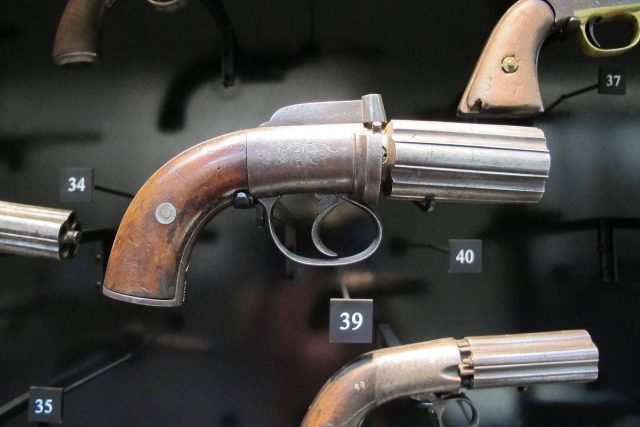 sextuple pepperboks
sextuple pepperboks
If we consider the traditional scheme, pepperboksy is characterized by the presence of six barrels of small length, It was also widely distributed model with four trunks, trunks were screwed into the rotating unit. General design were flint lock and bare shelf.
In all of the first models of unconventional weapons unit rotating arrow shafts by hand, to do so it was necessary to wear gloves, as the "exhaust" after the shot the barrel heated. Also, the arrow was necessary every time to pour on the shelf a new batch of powder, that did not increase the efficiency and rate of pepperboksa, but even in such a pistol he found its niche.
At first, it is the presence of a flint lock greatly reduces the possibility of multilateral pistols. After the appearance of the castle capsule they found a second life. Protorevolvery with a new capsule castle (Sometimes experts use, and such a symbol for pepperboksov) could boast of the ability of continuous shooting.
Cross on an unusual family of short firearms put it revolvers. Classic guns are widely used in the first half of the XIX century, and Samuel invention Colt, who improved their design, adding the automatic rotation of the drum, finally buried pepperboksy.
The idea of multilateral arms today
If you think, Multilateral that samples of small arms have been the victim of technological progress and were lost forever in the first half of the XIX century, you are wrong. Samples of multilateral arms were created in XX, and in the XXI century. In the Soviet Union on the basis of TKB machine-022 PM weapons designer Herman Korobov in 1962 he created, perhaps, The most interesting automatic weapons under the cartridge 7.62 mm caliber.
The designer has created a triple-Machine, which he named officially 7.62mm three barrels instrument for volley firing, weapons received index model 3B. Tree trunk, combined in one machine, crazy provided for such weapons firing rate - up 1400-1800 rounds per minute. In this part of the construction elements Korobow borrowed legendary Kalashnikov, which allowed not only to accelerate the development, but also greatly simplify the design itself unusual machine.
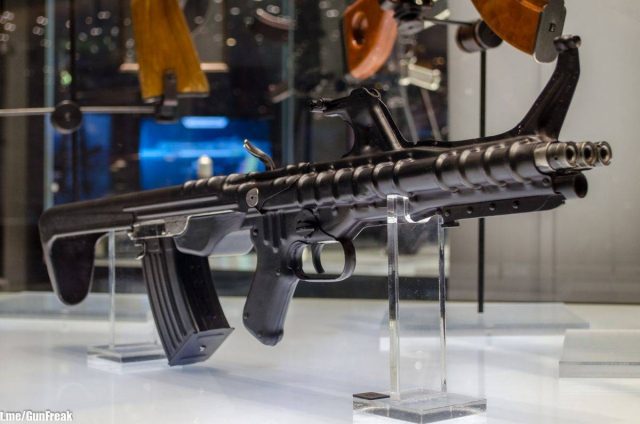 Triple-automatic TKB-059
Triple-automatic TKB-059
It is worth noting, Herman Korobov did not stop "3B" model, creating even more perfect triple-Machine, received index TCB-059. Its main difference from the precursor were smaller mass-dimensional characteristics, It managed to achieve this through the processing of some components of weapons and the introduction of new production technologies.
The model has been successfully tested, and it was a real military weapons. Moreover TCB-059 He showed excellent accuracy of fire, thanks to the almost simultaneous shot three rounds in a queue. The disadvantages of the weapon is the complexity of equipment cartridges, design specificity, All this, together with the absence of an acute need for the replacement of AKM and left a strange machine in the status of the experimental development.
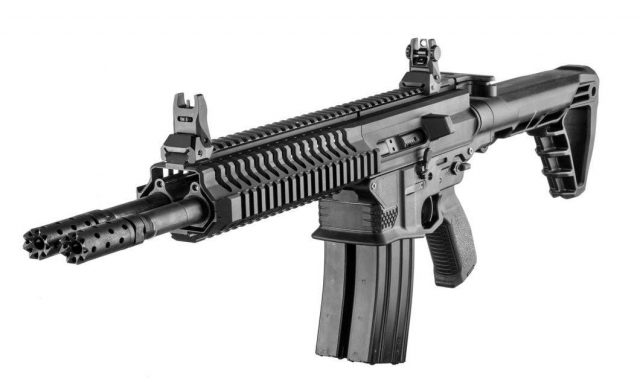 Double-barreled assault rifle Gilboa Snake
Double-barreled assault rifle Gilboa Snake
The idea of a multi-stemmed small arms is not lost in the XXI century. AT 2012 year at one of the exhibitions of Israeli arms company Silver Shadow designers showed the public his vision of the modern multilateral arms - automatic double-barreled rocket launchers called Gilboa Snake. In fact, is a modern assault rifle, which can be made in various calibers, base - under 5,56h45 mm NATO cartridge.
Its model of Israelis have created on the basis of a shortened version of assault rifle «Gilboa Commando». A new instance was extended receiver box, with which designers combined two barrel disposed parallel to each other at a distance of 30 mm.
It is important to understand, it's not a massive sample. Salvo Machine was originally developed for the needs of the special units of the IDF, weapons will never claim to be the mass for conventional weapons infantry units. The existence of such a double-barreled machine only expands opportunities SWAT, allowing you to use it if, when circumstances so require and environment.
/Sergey Yuferev, topwar.ru/











